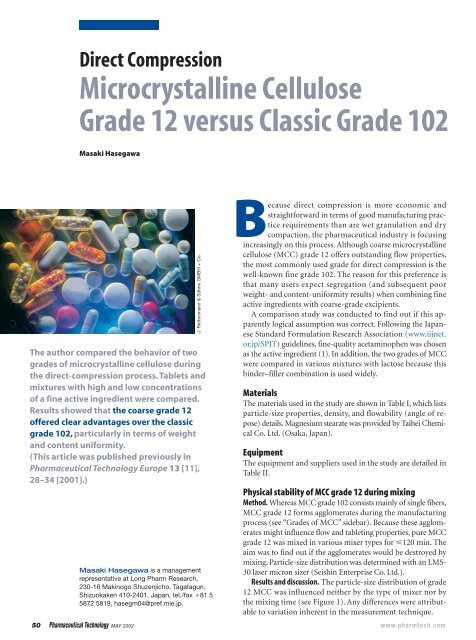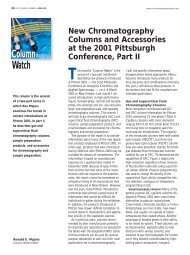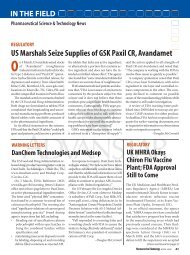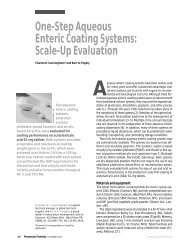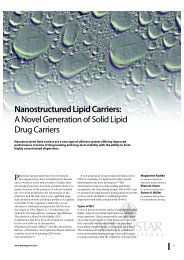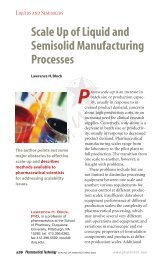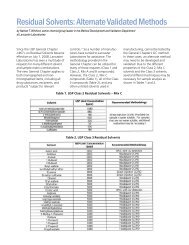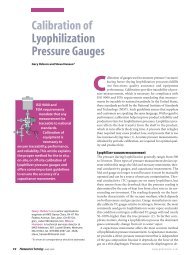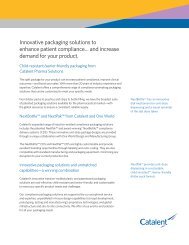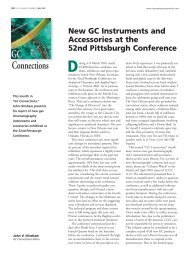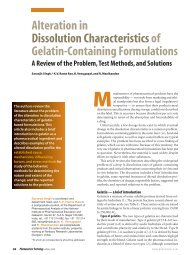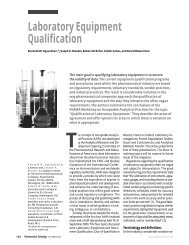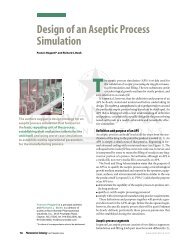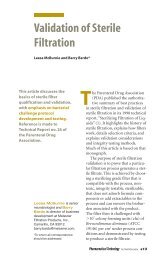Microcrystalline Cellulose Grade 12 versus Classic Grade 102
Microcrystalline Cellulose Grade 12 versus Classic Grade 102
Microcrystalline Cellulose Grade 12 versus Classic Grade 102
Create successful ePaper yourself
Turn your PDF publications into a flip-book with our unique Google optimized e-Paper software.
Direct Compression<br />
<strong>Microcrystalline</strong> <strong>Cellulose</strong><br />
<strong>Grade</strong> <strong>12</strong> <strong>versus</strong> <strong>Classic</strong> <strong>Grade</strong> <strong>102</strong><br />
Masaki Hasegawa<br />
The author compared the behavior of two<br />
grades of microcrystalline cellulose during<br />
the direct-compression process. Tablets and<br />
mixtures with high and low concentrations<br />
of a fine active ingredient were compared.<br />
Results showed that the coarse grade <strong>12</strong><br />
offered clear advantages over the classic<br />
grade <strong>102</strong>, particularly in terms of weight<br />
and content uniformity.<br />
(This article was published previously in<br />
Pharmaceutical Technology Europe 13 [11],<br />
28–34 [2001].)<br />
Masaki Hasegawa is a management<br />
representative at Long Pharm Research,<br />
230-16 Makinogo Shuzenjicho, Tagatagun,<br />
Shizuokaken 410-2401, Japan, tel./fax 81 5<br />
5872 5819, hasegm04@pref.mie.jp.<br />
J. Rettenmaier & Söhne GMBH + Co.<br />
Because direct compression is more economic and<br />
straightforward in terms of good manufacturing practice<br />
requirements than are wet granulation and dry<br />
compaction, the pharmaceutical industry is focusing<br />
increasingly on this process. Although coarse microcrystalline<br />
cellulose (MCC) grade <strong>12</strong> offers outstanding flow properties,<br />
the most commonly used grade for direct compression is the<br />
well-known fine grade <strong>102</strong>. The reason for this preference is<br />
that many users expect segregation (and subsequent poor<br />
weight- and content-uniformity results) when combining fine<br />
active ingredients with coarse-grade excipients.<br />
A comparison study was conducted to find out if this apparently<br />
logical assumption was correct. Following the Japanese<br />
Standard Formulation Research Association (www.iijnet.<br />
or.jp/SPJT) guidelines, fine-quality acetaminophen was chosen<br />
as the active ingredient (1). In addition, the two grades of MCC<br />
were compared in various mixtures with lactose because this<br />
binder–filler combination is used widely.<br />
Materials<br />
The materials used in the study are shown in Table I, which lists<br />
particle-size properties, density, and flowability (angle of repose)<br />
details. Magnesium stearate was provided by Taihei Chemical<br />
Co. Ltd. (Osaka, Japan).<br />
Equipment<br />
The equipment and suppliers used in the study are detailed in<br />
Table II.<br />
Physical stability of MCC grade <strong>12</strong> during mixing<br />
Method. Whereas MCC grade <strong>102</strong> consists mainly of single fibers,<br />
MCC grade <strong>12</strong> forms agglomerates during the manufacturing<br />
process (see “<strong>Grade</strong>s of MCC” sidebar). Because these agglomerates<br />
might influence flow and tableting properties, pure MCC<br />
grade <strong>12</strong> was mixed in various mixer types for <strong>12</strong>0 min. The<br />
aim was to find out if the agglomerates would be destroyed by<br />
mixing. Particle-size distribution was determined with an LMS-<br />
30 laser micron sizer (Seishin Enterprise Co. Ltd.).<br />
Results and discussion. The particle-size distribution of grade<br />
<strong>12</strong> MCC was influenced neither by the type of mixer nor by<br />
the mixing time (see Figure 1). Any differences were attributable<br />
to variation inherent in the measurement technique.<br />
50 Pharmaceutical Technology MAY 2002 www.pharmtech.com
<strong>Grade</strong>s of MCC<br />
<strong>Grade</strong> <strong>102</strong> (magnification 130 ) <strong>Grade</strong> <strong>12</strong> (magnification 130 )<br />
Particles passed (%)<br />
100.0<br />
80.0<br />
60.0<br />
40.0<br />
20.0<br />
0<br />
Without<br />
mixing<br />
V mixer<br />
(<strong>12</strong>0 min)<br />
Mechano<br />
mixer<br />
(30 min)<br />
Ribbon<br />
mixer<br />
(60 min)<br />
76.8 m 151.9 m 300.2 m<br />
Figure 1: Particle-size distribution of MCC grade <strong>12</strong>.<br />
Tablet hardness (kg)<br />
20<br />
16<br />
<strong>12</strong><br />
8<br />
4<br />
0<br />
0.8 1.2<br />
1.6<br />
Compaction force (t)<br />
MCC grade <strong>102</strong> (50% lactose)<br />
MCC grade <strong>12</strong> (50% lactose)<br />
MCC grade <strong>102</strong> (75% lactose)<br />
MCC grade <strong>12</strong> (75% lactose)<br />
Figure 2: Tablet hardness results (50 and 75% lactose, 40 rpm).<br />
Tableting of lactose–MCC mixtures<br />
Method. This test was conducted because coarse grades of lactose<br />
often are used as a filler in combination with MCC, particularly<br />
when low concentrations of active ingredient are used.<br />
Lactose (100 mesh) and MCC in various ratios were mixed in<br />
a ribbon mixer for 10 min. After magnesium stearate (0.5%)<br />
was added and mixing was performed for 1 min, 180-mg tablets<br />
were compressed on a rotary press (Aquarius 3, 8-mm flat<br />
punches) at 20 and 40 rpm and various compaction forces (0.4,<br />
0.8, 1.2 t). For formulations containing higher percentages of<br />
lactose (50 and 75%), tableting at a force of 0.4 t did not produce<br />
reasonable results — the tablets became weak and soft<br />
Table I: Materials and particle-size properties.<br />
Bulk Angle of<br />
Product Producer Lot No. Particle Size Density Repose<br />
<strong>Microcrystalline</strong> J. Rettenmaier & 560<strong>12</strong>90724 400 m: 1% 0.33 g/cm 3 36<br />
cellulose Söhne (Rosenberg, 560<strong>12</strong>91347 160 m: 45%<br />
(Vivapur <strong>12</strong>) Germany) 50 m: 89%<br />
<strong>Microcrystalline</strong> J. Rettenmaier & 56<strong>102</strong>95441 250 m: 1% 0.30 g/cm 3 42°<br />
cellulose Söhne 56<strong>102</strong>01008 75 m: 58%<br />
(Vivapur <strong>102</strong>) 32 m: 82%<br />
Lactose DMV International <strong>12</strong>0222 45 m: 18.5% 0.75 g/cm 3 39°<br />
(100 mesh) (Veghel, 150 m: 51.5%<br />
The Netherlands) 250 m: 88%<br />
Acetaminophen Yoshitomi Fine YO25 221 m: 97.7% 0.26 g/cm 3 60°<br />
powder (fine) Chemicals, Ltd. 140 m: 88.9%<br />
(Osaka, Japan) 74 m: 61.1%<br />
(see Figure 2). To show that tablets of acceptable<br />
hardness could be obtained from these<br />
mixtures, the test also was conducted at a compression<br />
force of 1.6 t. For this part of the study,<br />
the 45-punch press (production scale) with its<br />
larger turntable was chosen to increase mechanical<br />
stress. The author expected to see obvious<br />
differences in hardness when doing so.<br />
For the other parts of the study, a smaller,<br />
<strong>12</strong>-punch press was used because the formulation<br />
performance mainly was influenced by the mixing<br />
process.<br />
Results and discussion. For both grades of microcrystalline cellulose,<br />
tablet hardness decreased as the percentage of lactose<br />
increased. Comparing the results of tablets made with 100%<br />
MCC, those made with grade <strong>102</strong> were 36–63% harder than<br />
tablets made with grade <strong>12</strong> (see Figure 3). It is probable that<br />
the finer MCC particles (grade <strong>102</strong>) have larger surface areas<br />
with which to contact each other, resulting in higher hardness<br />
values. In addition, finer grades have a higher degree of crystallinity,<br />
which also could be a reason for these differences (2).<br />
Nevertheless, the grade <strong>12</strong> mixture with 75% lactose showed<br />
a tablet hardness of approximately<br />
4 kg at a compaction<br />
force of 1.6 t. This<br />
value is considered to be<br />
the minimum value for a<br />
satisfactory tablet (3,4).<br />
The influence of MCC on<br />
tablet hardness decreases<br />
with increasing percentages<br />
of lactose. In formulations<br />
with more than 25% lactose,<br />
the differences in<br />
hardness became irrelevant<br />
(see Figures 2 and 3). Because<br />
free-flowing lactose<br />
strongly influences the flow<br />
of the tableting mixture<br />
52 Pharmaceutical Technology MAY 2002 www.pharmtech.com
Tablet hardness (kg)<br />
20<br />
16<br />
<strong>12</strong><br />
8<br />
4<br />
0<br />
0.4 0.8<br />
Compaction force (t)<br />
MCC grade <strong>102</strong> (0% lactose)<br />
MCC grade <strong>12</strong> (0% lactose)<br />
MCC grade <strong>102</strong> (25% lactose)<br />
MCC grade <strong>12</strong> (25% lactose)<br />
when it is used in high concentrations, significant differences<br />
regarding tablet uniformity (weight, thickness, and hardness)<br />
were not observed. The results for tableting at 20 and 40 rpm<br />
were very similar; therefore, only the 40-rpm results are shown.<br />
Mixing and tableting of MCC with high concentrations of<br />
fine acetaminophen<br />
Method. Working with high concentrations of fine, powdered<br />
actives may cause problems during direct compression because<br />
of poor flow properties of the mixture. MCC was mixed with<br />
fine acetaminophen in various proportions (10, 25, and 50%<br />
acetaminophen) in a twin-shell mixer (V mixer) for 5, 15, and<br />
30 min. The author then tested the mixture for content uniformity<br />
by taking samples from three different points in the<br />
mixer (right side: 5 cm below the surface, left side: 5 cm below<br />
the surface, and middle: 5 cm above the bottom) with a sampling<br />
thief (4). In addition, the angle of repose and the compressibility<br />
(see explanation in this section) of the mixtures were<br />
determined. The angle of repose was measured using the Multi<br />
tester 1000 (Seishin Enterprise Co. Ltd.). In this measuring<br />
1.2<br />
Figure 3: Tablet hardness results (0 and 25% lactose, 40 rpm).<br />
Table II: Equipment and manufacturers.<br />
process, the material falls through a funnel onto a plate (8 cm<br />
in diameter) until a cone is formed and the addition of more<br />
material does not lead to a further increase in the cone’s height.<br />
The angle of repose is calculated using the plate’s diameter and<br />
the height of the cone. During the compressibility determination,<br />
the bulk density is measured as follows: The material falls<br />
through a funnel into a cup (100 mL in volume), and the density<br />
is calculated from the volume and weight of the cup before<br />
and after filling. Because the author expected the shortest mixing<br />
time to be the worst case in terms of tablet-weight variation<br />
and content uniformity, tablets were made from the 5-min<br />
mixture. After 0.5% magnesium stearate was added and mixing<br />
for an additional 5 min was performed, the mixture was<br />
compressed into 180-mg tablets on a rotary press (Correct <strong>12</strong><br />
8-mm flat punches, Kikusui Seisakusho Co. Ltd.) at 20 and 40<br />
rpm and a compaction force of 1.0 t. When a poorly flowing<br />
mixture is tableted at high speed, weight uniformity results will<br />
be worse than those of a free-flowing mixture because die filling<br />
will not be particularly uniform. In addition, the content<br />
uniformity of the mixture is influenced not only by the mixing<br />
step but by the tableting step as well. While flowing through the<br />
filling system of the machine, the mixture is influenced in a certain<br />
way. This influence might change when another speed is<br />
used, resulting in a different content uniformity. Therefore the<br />
author conducted tests at two different speeds. The tablets then<br />
were tested for weight variation and content uniformity.<br />
Results and discussion. The content uniformity (CV, relative<br />
standard deviation [RSD]) of the mixtures made with MCC grade<br />
<strong>12</strong> was better than that with grade <strong>102</strong> (see Figure 4), although<br />
the results were not absolutely uniform in this evaluation. In<br />
seven out of nine mixtures, the grade <strong>12</strong> results were better, and<br />
the average CV value was 1.9 compared with 3.9 for grade <strong>102</strong>.<br />
The advantage of grade <strong>12</strong> was particularly noticeable at short<br />
mixing times (5 min) when the average CV value was 1.2 compared<br />
with 3.8 for grade <strong>102</strong>. These results were confirmed by<br />
the tableting data. Regarding tablet content uniformity (RSD),<br />
grade <strong>12</strong> led to better results<br />
in all cases (see Figure 5).<br />
Machine Type/Size Manufacturer<br />
V mixer VM 5 Fuji Powdal Co. Ltd. (Osaka, Japan)<br />
(twin-shell mixer)<br />
Ribbon mixer AR-400 LK5 ERWEKA International AG (Baettwill,<br />
Switzerland)<br />
Mechano mixer Mechanomil Okada Seiko Co. Ltd. (Okayama, Japan)<br />
Rotary press Aquarius 3 (45 stations) Kikusui Seisakusho Co. Ltd. (Kyoto, Japan)<br />
Rotary press Clean Press Correct <strong>12</strong> HUK Kikusui Seisakusho Co. Ltd.<br />
(<strong>12</strong> stations)<br />
Punches 8 mm, biplane Kikusui Seisakusho Co. Ltd.<br />
Sampling thief 9 <strong>12</strong> 15 mm Shionogi Qualicaps (Osaka, Japan)<br />
Particle-size Laser micron sizer LMS-30 Seishin Enterprise Co. Ltd.<br />
determination<br />
(Osaka, Japan)<br />
Hardness tester TM 3-3 Kikusui Seisakusho Co. Ltd.<br />
Hardness tester Auto checker Okada Seiko Co. Ltd.<br />
Weight tester<br />
Chyo Balance Co. Ltd. (Kyoto, Japan)<br />
Thickness tester<br />
Ono Sokki Co. Ltd. (Yokohama, Japan)<br />
UV spectrometer UV 160 Shimadzu Seisakusho Co. Ltd. (Kyoto, Japan)<br />
Whereas the difference at a<br />
concentration of 10% acetaminophen<br />
is not great<br />
(0.3% at both speeds), the<br />
influence was more significant<br />
at 25% acetaminophen.<br />
In this example, the<br />
difference was 2% at 40 rpm<br />
and 2.2% at 20 rpm. Because<br />
of its poor flow properties,<br />
the 50% acetaminophen<br />
mixture was not compressible<br />
with grade <strong>102</strong> but<br />
showed good results with<br />
grade <strong>12</strong>. The weight uniformity<br />
of the tablets (see<br />
Figure 6) made with grade<br />
<strong>12</strong> also was better. The results<br />
were very similar to the<br />
54 Pharmaceutical Technology MAY 2002 www.pharmtech.com
CV value (%)<br />
CV value (%)<br />
7<br />
6<br />
5<br />
4<br />
3<br />
2<br />
1<br />
0<br />
5<br />
4<br />
3<br />
2<br />
1<br />
MCC grade <strong>12</strong>/10%<br />
acetaminophen<br />
MCC grade <strong>102</strong>/10%<br />
acetaminophen<br />
MCC grade <strong>12</strong>/25%<br />
acetaminophen<br />
MCC grade <strong>102</strong>/25%<br />
acetaminophen<br />
MCC grade <strong>12</strong>/50%<br />
acetaminophen<br />
MCC grade <strong>102</strong>/50%<br />
acetaminophen<br />
5 min mixing 15 min mixing 30 min mixing<br />
Figure 4: Content uniformity of the various mixtures.<br />
MCC grade <strong>12</strong><br />
MCC grade <strong>102</strong><br />
Taking into consideration that the content uniformity<br />
results of the mixtures were better for grade <strong>12</strong> (see<br />
Figures 4 and 9–11), the uniformity–nonuniformity<br />
in weight is not the only reason for the uniformity–<br />
nonuniformity of content, even if the weight uniformity<br />
does influence the results in a strong way.<br />
In general, the tableting results are more important<br />
than the mixing results because the tablet is the final<br />
product, and the content uniformity of the tablets can<br />
be determined more precisely in terms of sampling<br />
than can the content uniformity of the mixtures.<br />
Both angle of repose and compressibility are used<br />
as measurements for the determination and description<br />
of powder flow properties (low values indicate<br />
good flow in both instances). In the example<br />
of the 50% acetaminophen tablet, the angle of repose<br />
of the grade <strong>12</strong> mixture was almost the same as<br />
that of the grade <strong>102</strong> mixture (see Figure 7). It could<br />
be expected that these mixtures would behave similarly,<br />
but the grade <strong>102</strong> mixture was not workable<br />
because of poor flow properties; therefore, the correlation<br />
was not satisfactory in this case. In addition<br />
to the angle of repose, the compressibility — as an<br />
effective index of compressibility (6) and flowability<br />
(7) — was determined. It is calculated using the<br />
following equation:<br />
compressibility(%) <br />
bulk density(tapped) bulk density(loose)<br />
bulk density(tapped)<br />
100<br />
0<br />
10%<br />
20 rpm<br />
10%<br />
40 rpm<br />
Figure 5: Tablet content uniformity.<br />
25%<br />
20 rpm<br />
25%<br />
40 rpm<br />
50%<br />
20 rpm<br />
50%<br />
40 rpm<br />
The compressibility values (see Figure 8) indicate<br />
clear differences between the mixtures; therefore,<br />
they correlate better with the tableting results obtained<br />
than with the corresponding angle of repose<br />
values.<br />
CV value (%)<br />
5<br />
4<br />
3<br />
2<br />
1<br />
0<br />
10%<br />
20 rpm<br />
10%<br />
40 rpm<br />
Figure 6: Tablet weight variation.<br />
25%<br />
20 rpm<br />
25%<br />
40 rpm<br />
MCC grade <strong>12</strong><br />
MCC grade <strong>102</strong><br />
50%<br />
20 rpm<br />
content uniformity results: Differences between the two MCC<br />
grades increased as the percentage of acetaminophen increased.<br />
To what extent the uniformity–nonuniformity in terms of content<br />
derives from the uniformity–nonuniformity in terms of<br />
weight is difficult to express numerically because content uniformity<br />
is dependent on many influences beside tablet weight<br />
(e.g., mixture uniformity and mixture stability during tableting).<br />
50%<br />
40 rpm<br />
Mixing and tableting of MCC with low<br />
concentrations of fine acetaminophen<br />
Method. MCC was mixed with fine acetaminophen<br />
in various proportions (0.1, 1.0, and 5.0% acetaminophen)<br />
in a twin-shell mixer for 5, 10, 15, and<br />
30 min. The mixtures then were tested for content<br />
uniformity as described in the previous section. Because<br />
of the reasons mentioned in that section, tablets<br />
were made from the 5-min mixture. After 0.5% magnesium<br />
stearate was added and mixing was performed<br />
for an additional 5 min, the mixtures were<br />
compressed to 180-mg tablets on a rotary press (Correct<br />
<strong>12</strong> 8-mm flat punches) at 20 and 40 rpm and a<br />
compaction force of 1.0 t. The tablets were tested for weight<br />
variation and content uniformity.<br />
Results and discussion.As expected, the RSD of the mixtures<br />
decreased as the active-ingredient content increased. The values<br />
generally were much higher than those obtained from experiments<br />
involving high concentrations of acetaminophen (see the<br />
previous section). Mixtures of grade <strong>12</strong> showed better and more<br />
56 Pharmaceutical Technology MAY 2002 www.pharmtech.com
Structure of acetaminophen<br />
Before mixing<br />
After mixing<br />
consistent CV values than those of grade <strong>102</strong> (see<br />
Figures 9–11). Regarding tablet content uniformity,<br />
grade <strong>12</strong> showed better results than grade<br />
<strong>102</strong> (see Figure <strong>12</strong>). CV values for grade <strong>12</strong> were<br />
2.0–5.1% and 2.9–8.2% for grade <strong>102</strong>. The grade<br />
<strong>12</strong> results can be regarded as very good considering<br />
that, at such low active concentrations, a<br />
premix usually is done (it was not done to keep<br />
the results of the previous section and this section<br />
comparable).<br />
Angle of repose ()<br />
60<br />
55<br />
50<br />
45<br />
40<br />
35<br />
30<br />
10 25<br />
Acetaminophen (%)<br />
MCC grade <strong>102</strong><br />
MCC grade <strong>12</strong><br />
50<br />
Compressibility (%)<br />
40<br />
30<br />
20<br />
10<br />
0<br />
10 25<br />
Acetaminophen (%)<br />
MCC grade <strong>102</strong><br />
MCC grade <strong>12</strong><br />
50<br />
Figure 7: Angle of repose of the various mixtures.<br />
Figure 8: Compressibility of the various mixtures.<br />
CV value (%)<br />
60<br />
50<br />
40<br />
30<br />
20<br />
10<br />
0<br />
5 10 15<br />
MCC grade <strong>102</strong>, 0.1%<br />
MCC grade <strong>12</strong>, 0.1%<br />
Mixing time (min)<br />
Figure 9: Content uniformity of the mixture: 0.1% acetaminophen.<br />
30<br />
CV value (%)<br />
60<br />
50<br />
40<br />
30<br />
20<br />
10<br />
0<br />
5 10 15<br />
Mixing time (min)<br />
MCC grade <strong>102</strong>, 1.0%<br />
MCC grade <strong>12</strong>, 1.0%<br />
Figure 10: Content uniformity of the mixture: 1.0% acetaminophen.<br />
30<br />
CV value (%)<br />
60<br />
50<br />
40<br />
30<br />
20<br />
10<br />
0<br />
5 10 15<br />
Mixing time (min)<br />
MCC grade <strong>102</strong>, 5.0%<br />
MCC grade <strong>12</strong>, 5.0%<br />
Figure 11: Content uniformity of the mixture: 5.0% acetaminophen.<br />
30<br />
Conclusions<br />
Tablets made of MCC grade <strong>102</strong> showed slight advantages regarding<br />
hardness. This influence became smaller with increasing<br />
active concentrations, therefore the practical relevance can<br />
be regarded as low when summarizing the advantages of grade<br />
<strong>12</strong> in this study. Working with coarse material generally offers<br />
some practical advantages such as less dust development during<br />
production. MCC grade <strong>12</strong> showed a higher load capacity<br />
for fine actives because of improved flow properties. It led to<br />
better results regarding the content uniformity of both mixtures<br />
and tablets even when working with low concentrations of fine<br />
actives and short mixing times. Segregation, seen when fine active<br />
ingredients are combined with coarse excipients, was not<br />
observed, although it may have been expected from a physical<br />
standpoint. It has been found that acetaminophen of the quality<br />
used in this study consists of small agglomerates (see “Struc-<br />
58 Pharmaceutical Technology MAY 2002 www.pharmtech.com
ture of acetaminophen” sidebar, left picture). During<br />
mixing, these agglomerates are destroyed and the distributed<br />
single particles stick to the surface of the<br />
MCC (see “Structure of acetaminophen” sidebar, right<br />
picture).<br />
It seems that an interparticulate force between the<br />
two components is formed that is stronger than the<br />
tendency to segregate (resulting from the differences<br />
in particle size). It also must be considered that MCC<br />
is a material of crystalline structure with irregular<br />
surfaces, which makes it easy for small particles to<br />
cut teeth in.<br />
Acknowledgments<br />
The author would like to acknowledge Professor H.<br />
Sunada (Meijo University, Nagoya, Japan) for support and discussions<br />
relating to this article and Mr. Stephan Wohlrab (J. Rettenmaier<br />
& Söhne GmbH Co., Rosenberg, Germany) for providing<br />
the MCC materials and arranging this article.<br />
References<br />
1. H. Sunada et al., “Study of Standard Tablet Formulation Based on<br />
Granulation,” J. Soc. Powder Tech. Jpn 34, 785–795 (1997).<br />
2. Study at Martin Luther University, Halle, Germany, using X-ray diffraction<br />
for J. Rettenmeier & Söhne GmbH Co., Regensberg, Germany,<br />
1999.<br />
3. Remington’s Pharmaceutical Sciences; E.W. Martin and E.F. Cook, Eds.<br />
CV value (%)<br />
10<br />
8<br />
6<br />
4<br />
2<br />
0<br />
0.1% active<br />
20 rpm<br />
0.1% active<br />
40 rpm<br />
1.0% active<br />
20 rpm<br />
Figure <strong>12</strong>: Content uniformity of the tablets.<br />
1.0% active<br />
40 rpm<br />
MCC grade <strong>12</strong><br />
MCC grade <strong>102</strong><br />
5.0% active<br />
20 rpm<br />
5.0% active<br />
40 rpm<br />
(Mack Publishing Co., Easton, PA, 16th ed., 1980), p. 1558.<br />
4. M. Hasegawa, A. Ohtsuka, and M. Shinoda,“Evaluation of Techniques<br />
for Determining the Strength of Flat-Faced Lactose–Starch Tablets,”<br />
Pharm. Sci. Tech. Jpn 41 (3), 146–154 (1981).<br />
5. T. Makino et al., “Study of Granulation Methods and Content Uniformity,”<br />
Proceedings of the 15th Conference of the Japanese Standard<br />
Formulation Research Association (Hamamatsu, Japan, 1999),<br />
pp. 34–39.<br />
6. M. Hasegawa, A. Ohtsuka, and F. Higashide, “Effect of Mixing Ratio<br />
on Tensile Strength of Lactose–Starch Tablets,” Pharm. Sci. Tech. Jpn<br />
46 (2), 110–118 (1986).<br />
7. P. Szabó-Révész et al., “Comparison between <strong>Microcrystalline</strong> <strong>Cellulose</strong>s<br />
in the Direct-Compression Process,” Pharm. Technol. Eur. 8 (4),<br />
31–39 (1996). PT<br />
Circle/eINFO 43<br />
60 Pharmaceutical Technology MAY 2002 www.pharmtech.com


